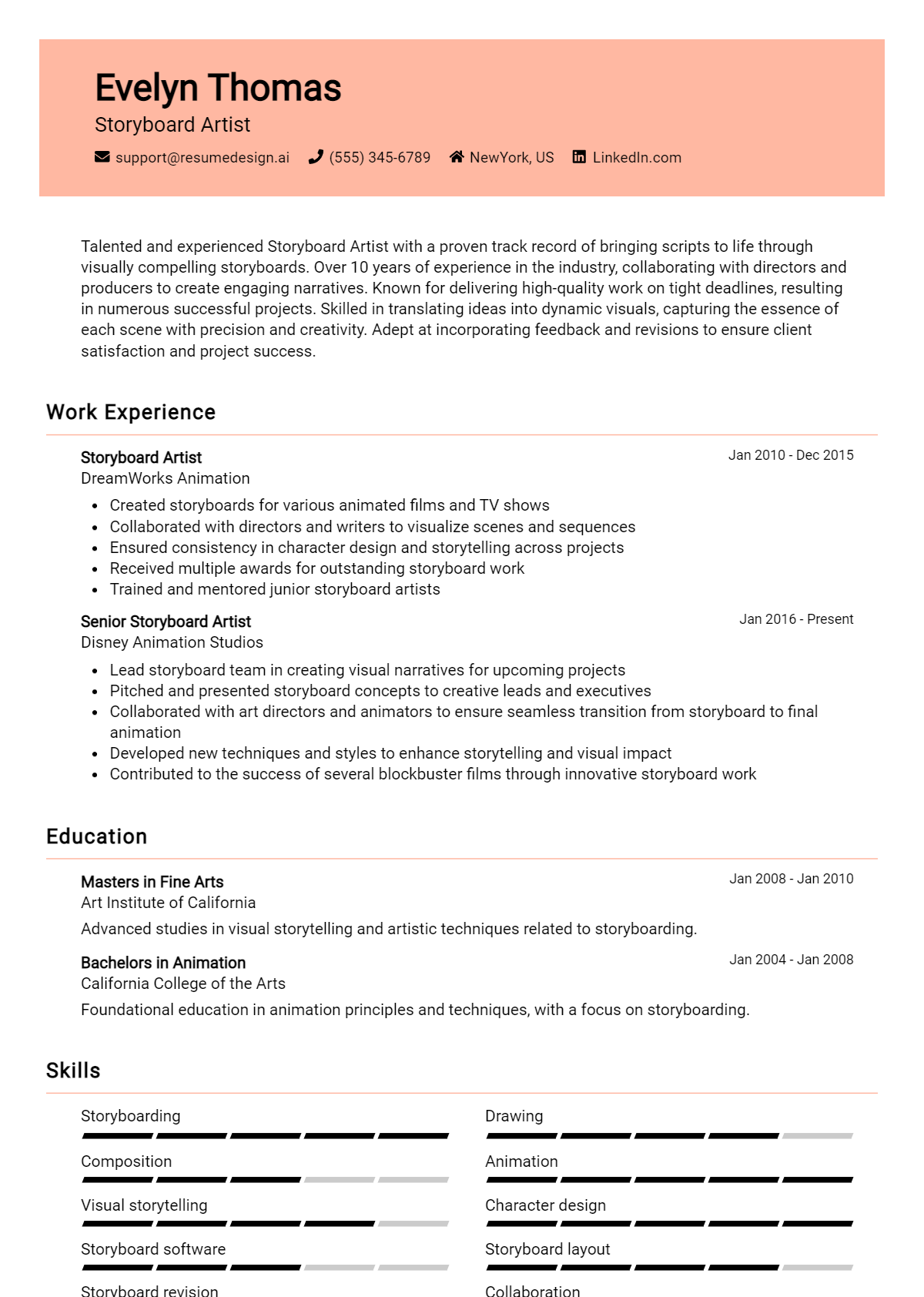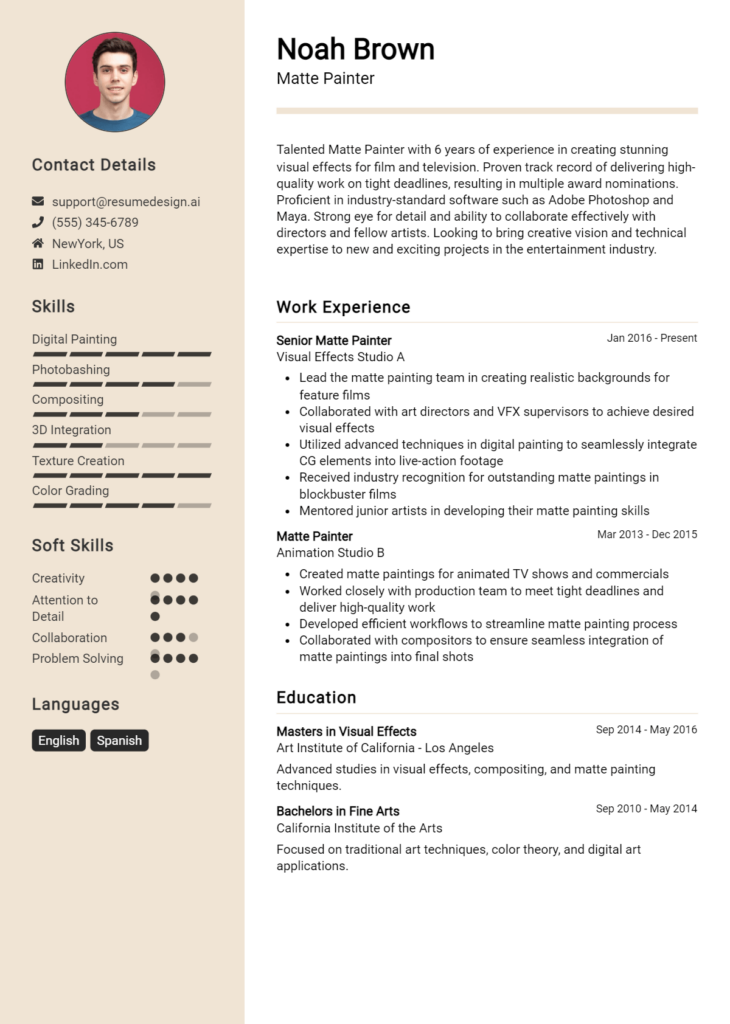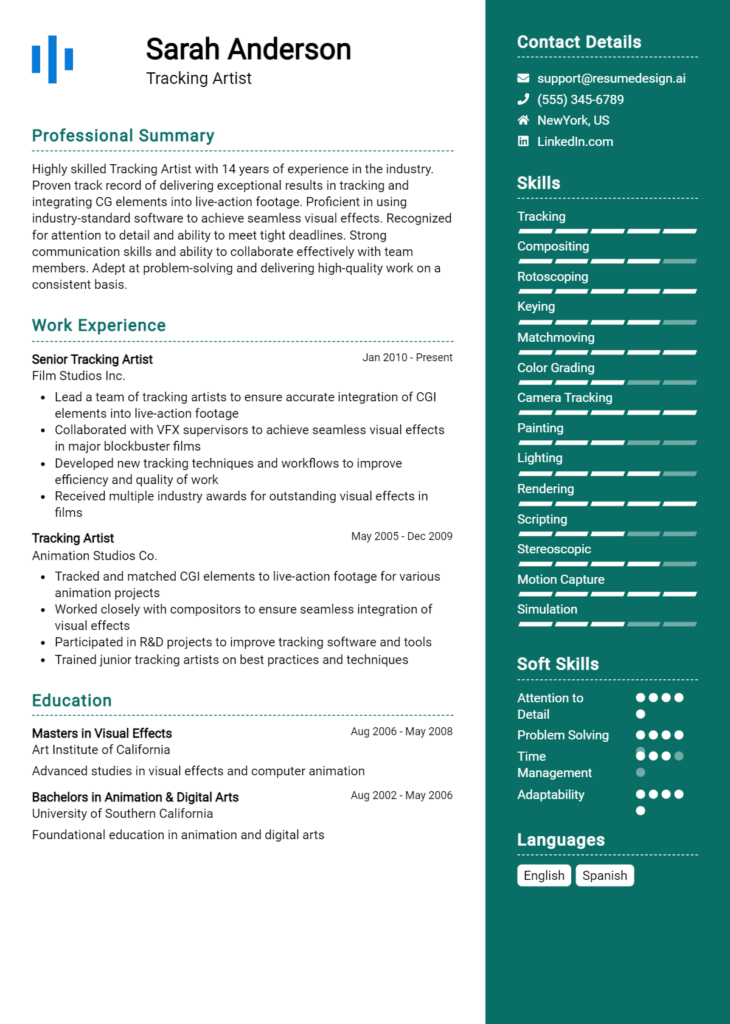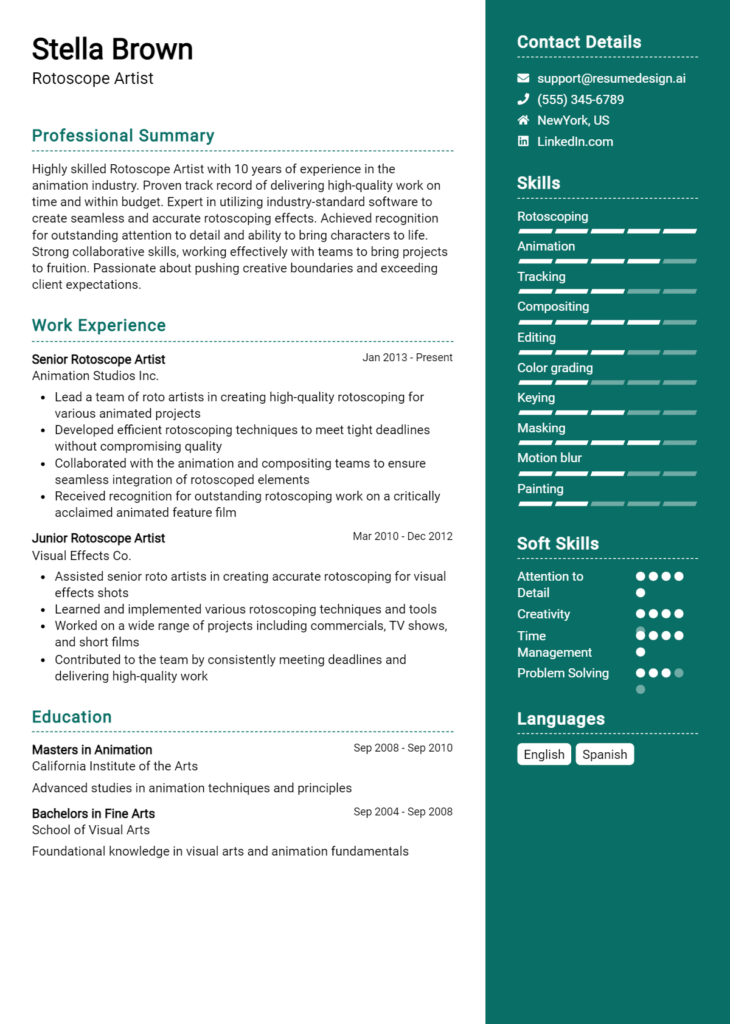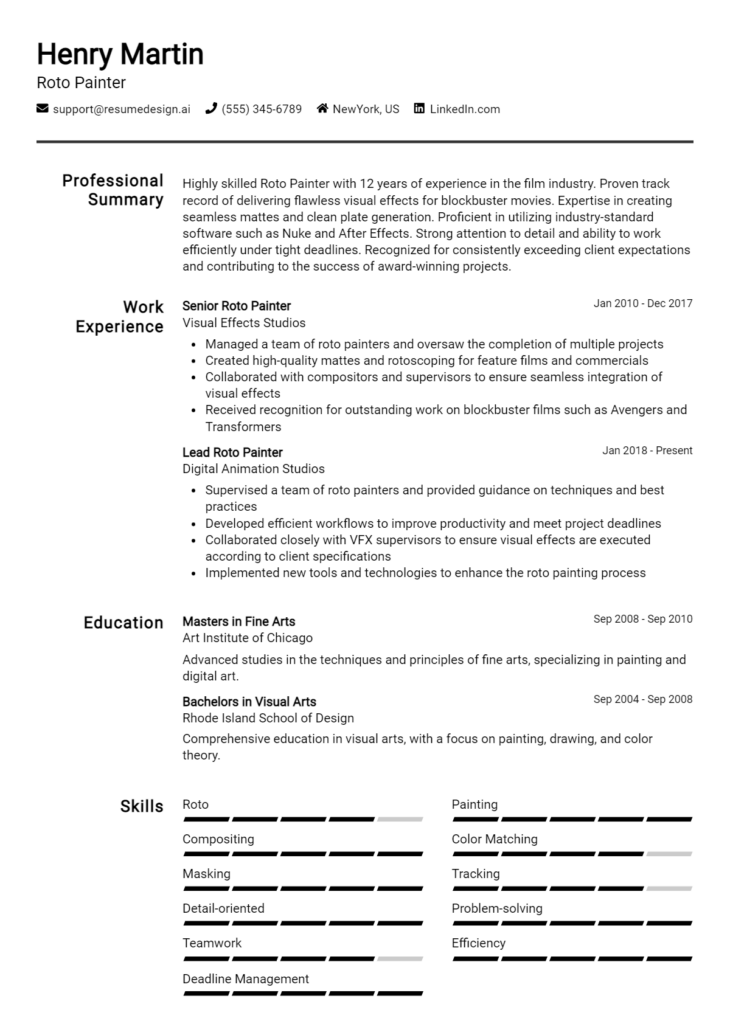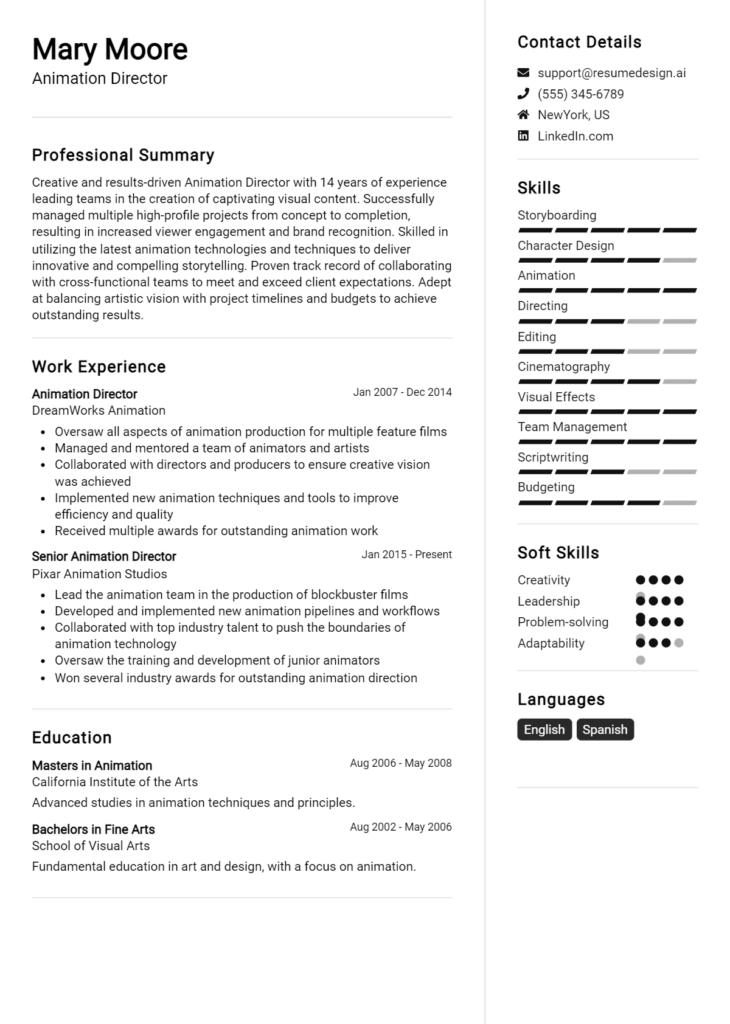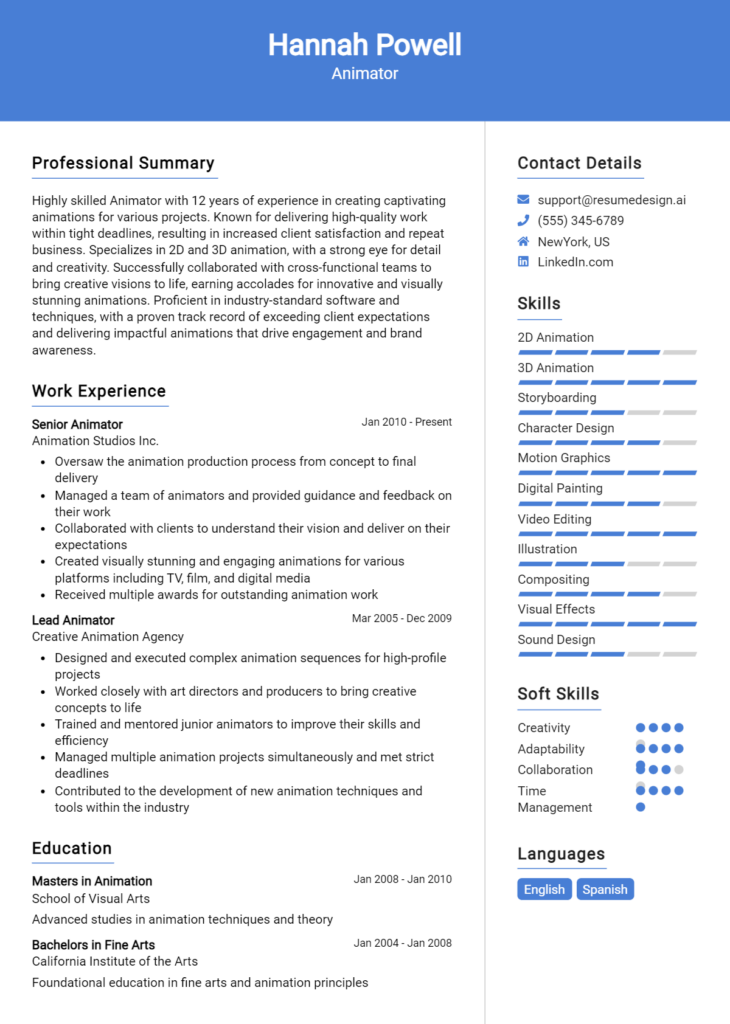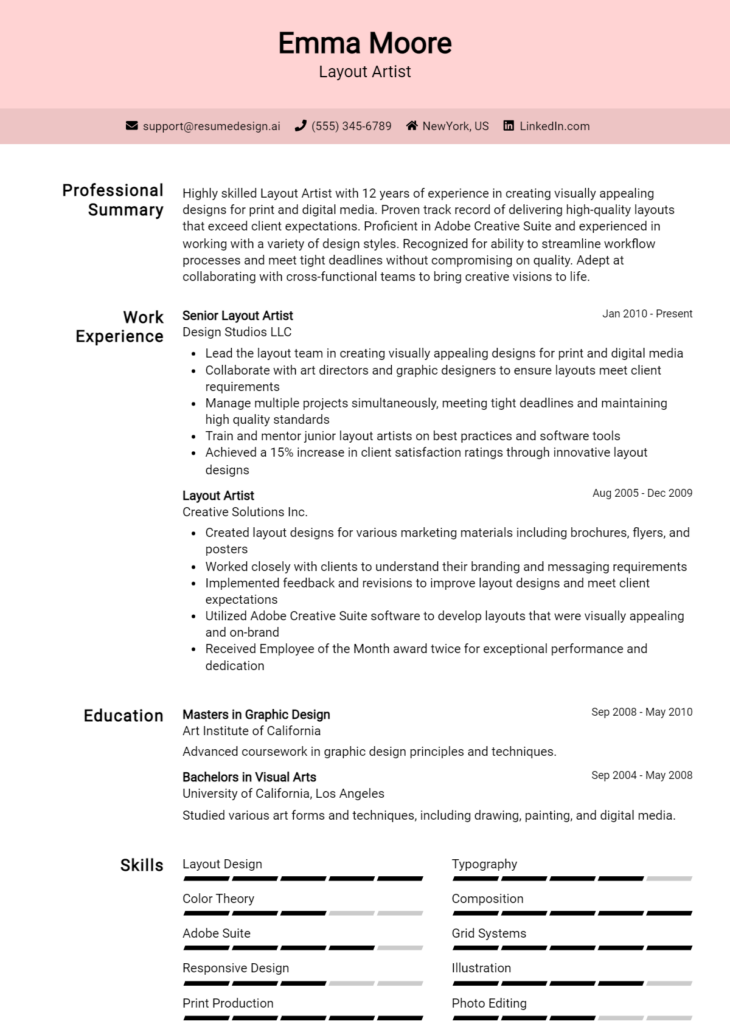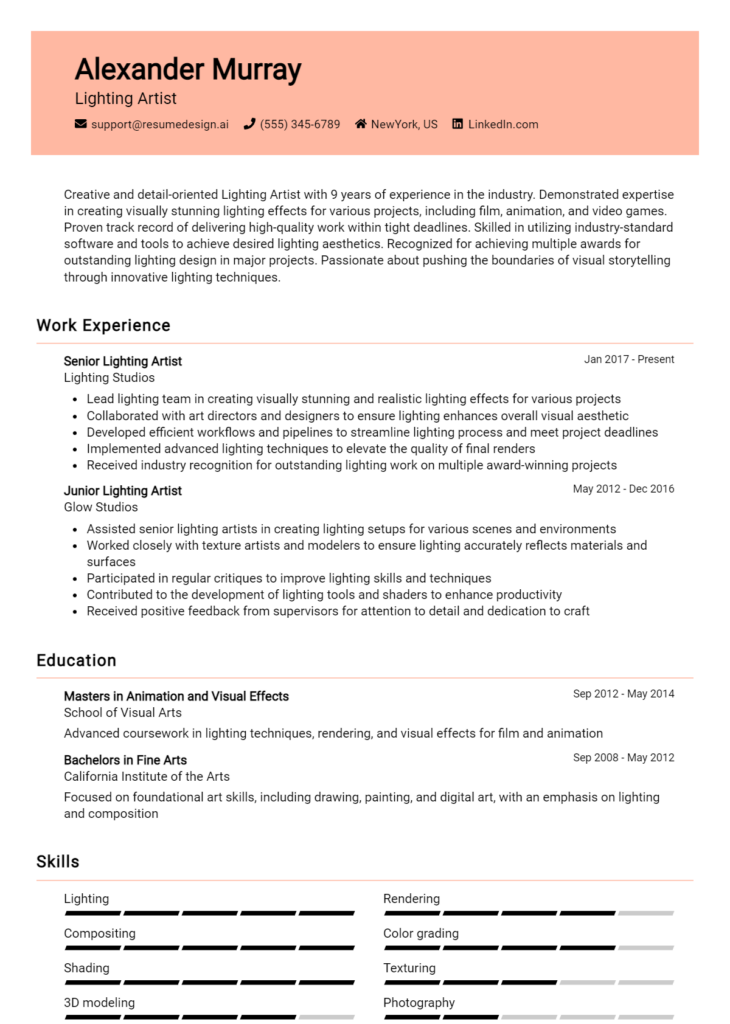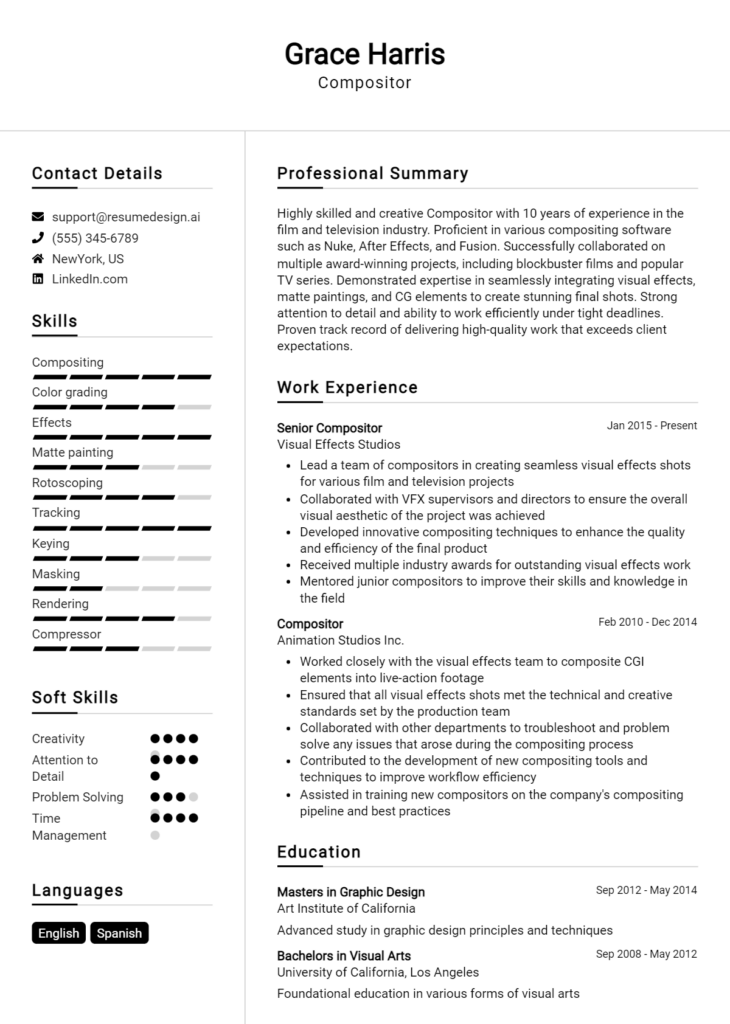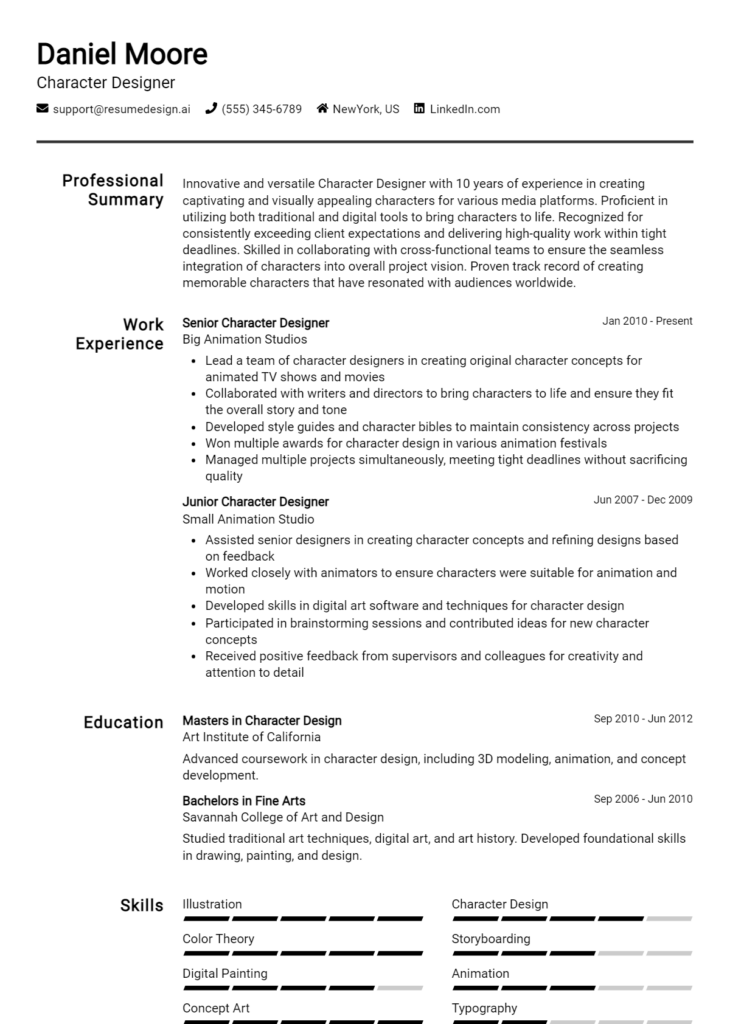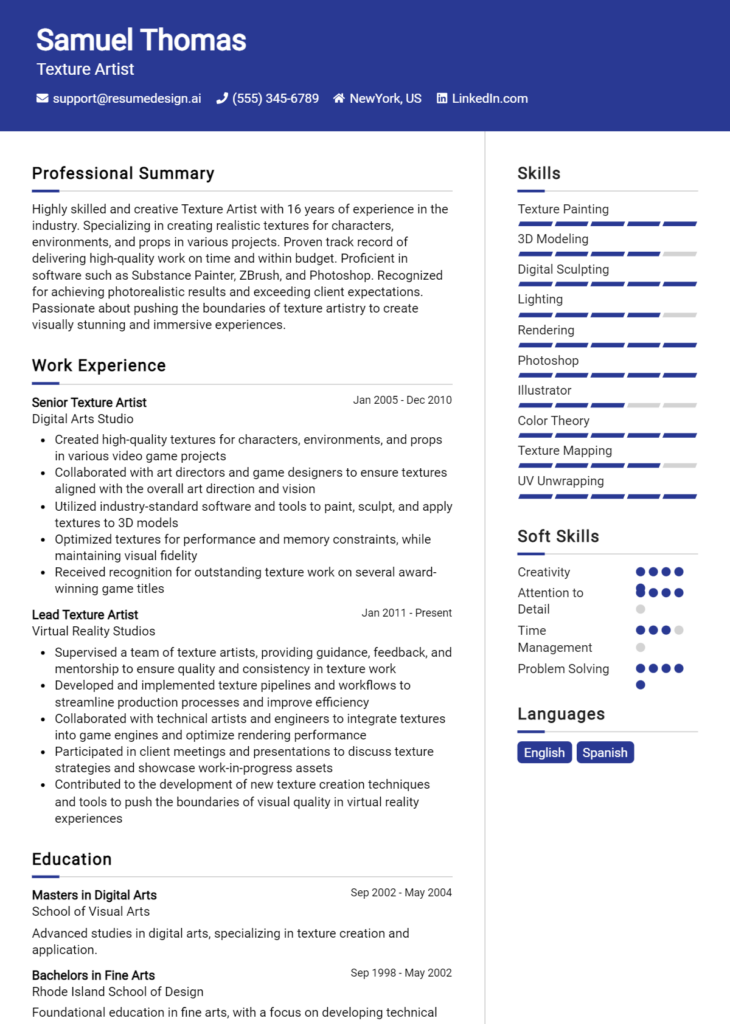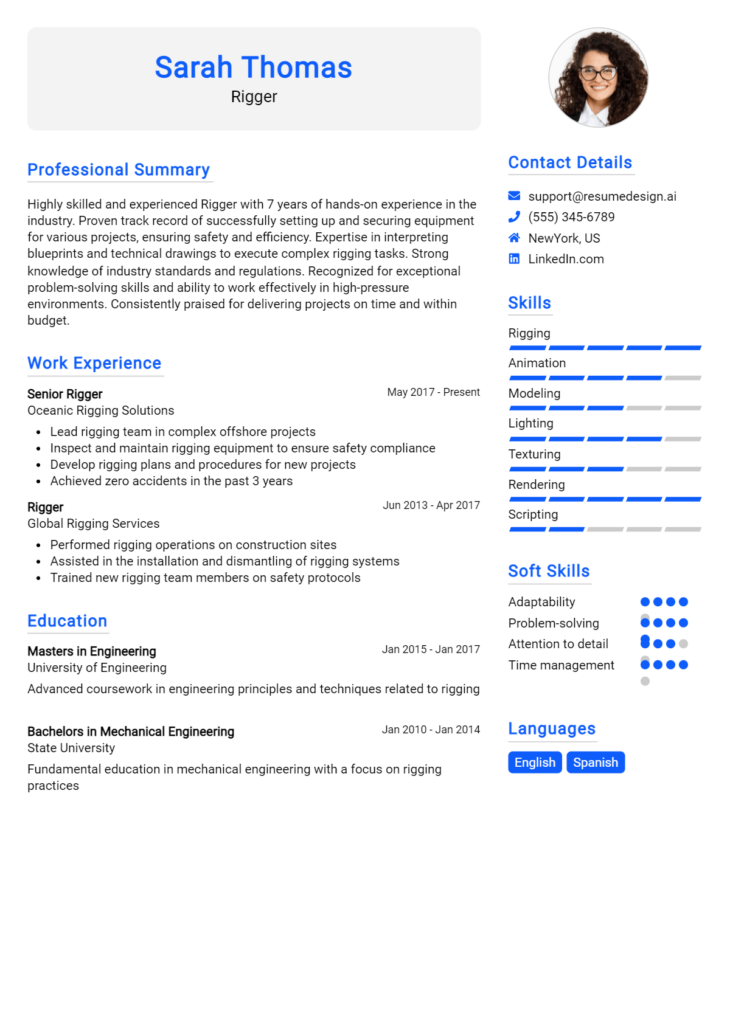Storyboard Artist Core Responsibilities
A Storyboard Artist plays a crucial role in visual storytelling, bridging the gap between writers, directors, and animators. Key responsibilities include creating detailed sketches that outline scenes, developing visual narratives, and collaborating with various departments to ensure seamless production. Successful storyboard artists possess strong technical skills in drawing and software, along with operational abilities to manage timelines. Problem-solving skills are essential for addressing creative challenges. A well-structured resume effectively highlights these qualifications, showcasing how they contribute to the organization's overall goals.
Common Responsibilities Listed on Storyboard Artist Resume
- Developing storyboards that align with the script and vision of the project
- Creating detailed visual representations of scenes and sequences
- Collaborating with directors, writers, and animators to refine visual concepts
- Incorporating feedback from team members and stakeholders
- Maintaining consistency in style and character design
- Utilizing software tools for digital storyboarding
- Presenting storyboards to clients and production teams
- Managing time efficiently to meet project deadlines
- Researching visual styles and techniques to enhance storytelling
- Participating in brainstorming sessions to generate creative ideas
- Adapting storyboards based on production needs and constraints
High-Level Resume Tips for Storyboard Artist Professionals
In the competitive world of visual storytelling, a well-crafted resume serves as a storyboard for your professional journey, offering potential employers a glimpse into your skills, creativity, and achievements. For Storyboard Artist professionals, this document often represents the first impression you make, making it essential to ensure it accurately reflects your unique talents and experiences. A compelling resume not only showcases your artistic abilities but also highlights your technical skills, project experience, and collaborative spirit. In this guide, we will provide practical and actionable resume tips specifically tailored for Storyboard Artist professionals to help you stand out in a crowded job market.
Top Resume Tips for Storyboard Artist Professionals
- Tailor your resume to each job description by incorporating relevant keywords and phrases that align with the employer's requirements.
- Showcase your relevant experience by detailing specific projects you've worked on, including the type of media (film, animation, video games) and your role in the process.
- Quantify your achievements wherever possible, such as the number of storyboards created, deadlines met, or projects completed successfully.
- Highlight industry-specific skills, including proficiency in software like Adobe Photoshop, Storyboard Pro, or other relevant tools.
- Include a portfolio link to showcase your best storyboard samples, as visual evidence of your skills is crucial in this field.
- Use clear, concise language and an organized layout to ensure your resume is easy to read and visually appealing.
- Mention any collaborative experiences with directors, writers, or other artists to demonstrate your teamwork and communication skills.
- Keep your resume to one or two pages, focusing on the most relevant information to maintain the hiring manager's attention.
- Incorporate any relevant education or training, such as degrees in animation, fine arts, or specific courses in storyboard techniques.
- Utilize action verbs to describe your roles and contributions, making your resume more dynamic and engaging.
By implementing these tips, you can create a compelling resume that effectively showcases your unique strengths as a Storyboard Artist. A polished and targeted resume not only increases your chances of catching the attention of hiring managers but also positions you as a strong candidate in the competitive landscape of the storyboard industry.
Why Resume Headlines & Titles are Important for Storyboard Artist
In the competitive field of storyboard artistry, a well-crafted resume headline or title plays a crucial role in capturing the attention of hiring managers. This concise phrase serves as the first impression, summarizing a candidate's key qualifications and unique strengths in relation to the job. A strong headline not only grabs the reader's attention but also communicates relevant skills and experiences that are vital for the role. Therefore, it is essential for storyboard artists to create headlines that are both impactful and directly aligned with the job they are applying for, ensuring they stand out in a sea of applicants.
Best Practices for Crafting Resume Headlines for Storyboard Artist
- Keep it concise: Aim for clarity and brevity in your headline.
- Be role-specific: Tailor your headline to reflect the specific job title you are applying for.
- Highlight key skills: Include your most relevant skills that align with the job requirements.
- Showcase your experience: Mention years of experience or specific industries you have worked in.
- Use strong action words: Choose impactful verbs that demonstrate your capabilities.
- Incorporate relevant keywords: Use industry-specific terminology to enhance visibility.
- Avoid generic phrases: Steer clear of vague language that fails to convey your unique qualifications.
- Make it compelling: Create intrigue that encourages the hiring manager to read further.
Example Resume Headlines for Storyboard Artist
Strong Resume Headlines
Creative Storyboard Artist with 5+ Years in Animation and Film
Award-Winning Storyboard Artist Specializing in Visual Narrative Development
Experienced Storyboard Artist with Expertise in Character Design and Scene Composition
Weak Resume Headlines
Storyboard Artist Looking for Opportunities
Creative Individual with Artistic Skills
The strong headlines are effective because they quickly communicate specific qualifications and experiences, making it easy for hiring managers to see the candidate's value. They are tailored, precise, and relevant to the storyboard artist role, which increases the chances of capturing attention. In contrast, the weak headlines fail to impress due to their vagueness and lack of specificity; they do not provide any insight into the candidate's unique abilities or contributions, making them forgettable in a competitive job market.
Writing an Exceptional Storyboard Artist Resume Summary
A resume summary is a crucial element for a Storyboard Artist, as it serves as the first impression a hiring manager will have of the candidate. A well-crafted summary quickly captures attention by effectively showcasing key skills, relevant experience, and notable accomplishments. This brief overview should be concise yet impactful, tailored specifically to align with the job description, ensuring that it resonates with the employer and highlights why the candidate is a perfect fit for the role.
Best Practices for Writing a Storyboard Artist Resume Summary
- Quantify Achievements: Use numbers to demonstrate the impact of your work, such as the number of projects completed or the size of the team you collaborated with.
- Focus on Skills: Highlight key skills that are directly relevant to storyboard artistry, such as visualization, creativity, and proficiency in software like Adobe Creative Suite.
- Tailor to the Job Description: Customize your summary for each application to reflect the specific requirements and keywords mentioned in the job listing.
- Keep it Concise: Aim for 2-4 sentences that succinctly encapsulate your experience and goals without overwhelming the reader.
- Showcase Relevant Experience: Include details about previous roles that directly relate to storyboarding, such as experience in animation, film, or advertising.
- Use Action Words: Start sentences with strong action verbs to convey confidence and proactivity, such as "developed," "collaborated," or "produced."
- Highlight Industry Knowledge: Mention any specific genres or styles you are familiar with, which can make you stand out in a competitive field.
- Demonstrate Passion: Convey your enthusiasm for storytelling and visual communication, as passion can set you apart from other candidates.
Example Storyboard Artist Resume Summaries
Strong Resume Summaries
Creative Storyboard Artist with over 5 years of experience in animation and film production, having successfully developed storyboards for more than 20 short films and commercials, resulting in a 30% increase in viewer engagement.
Detail-oriented Storyboard Artist skilled in Adobe Creative Suite and Toon Boom, recognized for conceptualizing engaging narratives that have won multiple awards at international film festivals, including Best Short Film at the 2022 Indie Film Awards.
Versatile Storyboard Artist with a proven track record of collaborating with cross-functional teams to create visually compelling storyboards; played a key role in a project that generated $500K in revenue through innovative storytelling techniques.
Weak Resume Summaries
Storyboard Artist with experience in various projects looking for new opportunities to create visual stories.
Creative individual seeking a position as a Storyboard Artist, with some background in graphic design and animation.
The strong resume summaries stand out due to their specificity, quantifiable results, and direct relevance to the role of a Storyboard Artist. They highlight concrete achievements and skills that align with industry expectations. In contrast, the weak summaries lack detail and impact, making them too generic and unmemorable for hiring managers looking for candidates who can demonstrate their value effectively.
Work Experience Section for Storyboard Artist Resume
The work experience section of a Storyboard Artist resume is crucial as it serves as a comprehensive showcase of the candidate's technical skills, collaborative abilities, and overall effectiveness in delivering high-quality products. This section allows candidates to demonstrate their expertise in visual storytelling, proficiency with industry-standard software, and capacity to manage teams and projects effectively. Highlighting quantifiable achievements—such as improved project turnaround times or increased viewer engagement—can significantly bolster a resume, while aligning experiences with industry standards ensures relevance and appeal to potential employers.
Best Practices for Storyboard Artist Work Experience
- Utilize action verbs to describe accomplishments and responsibilities.
- Quantify achievements where possible, using metrics to illustrate impact.
- Highlight specific technical skills relevant to the position, such as software proficiency.
- Emphasize collaboration by mentioning teamwork and cross-departmental projects.
- Tailor work experience descriptions to align with the job description of the role you are applying for.
- Include notable projects or clients to enhance credibility and recognition.
- Describe the creative process and methodologies used in projects.
- Keep descriptions concise but informative, focusing on key contributions.
Example Work Experiences for Storyboard Artist
Strong Experiences
- Led a team of 5 storyboard artists in developing a 12-episode animated series, resulting in a 30% reduction in production time compared to previous projects.
- Created dynamic storyboards for a major film release that achieved over 2 million views in its first week, contributing to the film's success.
- Collaborated closely with directors and producers to refine visual concepts, enhancing the narrative flow and achieving a 95% approval rating in focus groups.
- Implemented a new digital workflow that improved team efficiency by 40%, allowing for quicker iterations and feedback loops.
Weak Experiences
- Worked on various projects with little detail about specific contributions or outcomes.
- Assisted in storyboarding for a few episodes without mentioning the impact or results.
- Involved in team meetings and discussions but did not detail the role in the creative process.
- Responsible for drawing storyboards without specifying software skills or techniques used.
The examples of strong experiences illustrate clear, quantifiable outcomes and significant contributions to projects, showcasing both technical expertise and collaborative efforts. In contrast, the weak experiences lack specificity and measurable results, making them less impactful and memorable to potential employers. Strong experiences effectively highlight the candidate's value, while weak experiences fail to convey the candidate's true capabilities and achievements.
Education and Certifications Section for Storyboard Artist Resume
The education and certifications section of a Storyboard Artist resume is crucial in showcasing a candidate's academic background and their commitment to professional growth within the industry. This section not only highlights formal education but also emphasizes any industry-relevant certifications and specialized training that can enhance a candidate's credibility. By providing details on relevant coursework and continuous learning efforts, candidates can demonstrate their preparedness for the demands of the role and their dedication to honing their artistic skills, making them more attractive to potential employers.
Best Practices for Storyboard Artist Education and Certifications
- Prioritize relevant degrees in Animation, Fine Arts, or Film Studies.
- List industry-recognized certifications such as those from the Animation Guild or similar organizations.
- Include specific courses that relate directly to storyboarding, character design, or visual storytelling.
- Highlight any workshops or training sessions attended that focus on software tools like Adobe Creative Suite or Toon Boom.
- Keep the information concise, including only the most pertinent details to maintain clarity.
- Maintain chronological order, listing the most recent qualifications first for easy reference.
- Showcase any ongoing education efforts to illustrate a commitment to staying current in the field.
- Consider adding GPA or honors if they are impressive and relevant to the position.
Example Education and Certifications for Storyboard Artist
Strong Examples
- Bachelor of Fine Arts in Animation, University of Southern California, 2020
- Certification in Storyboarding for Animation, Animation Mentor, 2021
- Completed coursework in Visual Storytelling and Character Development, School of Visual Arts
- Advanced Training in Adobe After Effects and Toon Boom Storyboard Pro, 2022
Weak Examples
- Associate Degree in General Studies, Community College, 2018
- Certification in Graphic Design (not specifically related to storyboarding), 2019
- Outdated coursework in Traditional Drawing Techniques, attended in 2015
- High School Diploma, 2016
The strong examples are considered effective because they are directly relevant to the role of a Storyboard Artist, showcasing specialized training and education that aligns with industry standards. They demonstrate a clear focus on skills that are necessary for success in storyboarding. In contrast, the weak examples are less effective as they either lack relevance to the role or are outdated, failing to demonstrate the candidate's current capabilities or commitment to professional development in the field of storyboarding.
Top Skills & Keywords for Storyboard Artist Resume
As a Storyboard Artist, possessing the right skills is crucial for creating compelling visual narratives that effectively communicate the storyline and character arcs of a project. A well-structured resume that highlights both hard and soft skills can significantly enhance an artist's chances of landing their desired position. Hard skills showcase technical proficiency and artistic abilities, while soft skills reflect interpersonal traits and creative thinking. Both categories are essential for collaborating with directors, animators, and other team members in the fast-paced world of visual storytelling. By emphasizing these key skills, a storyboard artist can demonstrate their capability to contribute to a project’s success.
Top Hard & Soft Skills for Storyboard Artist
Soft Skills
- Creativity
- Communication
- Collaboration
- Problem-solving
- Adaptability
- Attention to detail
- Time management
- Critical thinking
- Empathy
- Open-mindedness
Hard Skills
- Proficiency in storyboard software (e.g., Storyboard Pro, Photoshop)
- Drawing and illustration techniques
- Understanding of cinematography
- Knowledge of animation principles
- Script analysis
- Digital painting
- Character design
- Visual storytelling
- Layout and composition
- Basic video editing
For more insights on enhancing your resume with the right skills, you can explore our comprehensive guide on skills and ensure your work experience aligns with the job requirements.
Stand Out with a Winning Storyboard Artist Cover Letter
I am writing to express my enthusiasm for the Storyboard Artist position at [Company Name], as advertised on [where you found the job listing]. With a strong background in visual storytelling and a keen eye for detail, I am excited about the opportunity to contribute to your team. My experience in both traditional and digital mediums allows me to create compelling storyboards that effectively communicate the narrative and vision of a project.
In my previous role at [Previous Company Name], I collaborated closely with directors, animators, and writers to develop storyboards for various projects, including animated series and feature films. I take pride in my ability to interpret scripts and translate them into visual sequences that capture the essence of the story. My proficiency in software such as Adobe Photoshop, Toon Boom Storyboard Pro, and Sketchbook enables me to produce high-quality boards efficiently while remaining adaptable to the specific needs of each project.
I am particularly drawn to [Company Name] because of your commitment to innovative storytelling and unique visual styles. I admire your recent work on [specific project or film], as it showcases a strong blend of creativity and technical skill. I am eager to bring my passion for storytelling and my artistic abilities to your team, collaborating to push the boundaries of visual narrative and engage audiences in new and exciting ways.
Thank you for considering my application. I am looking forward to the possibility of discussing how my skills and experiences align with the vision of [Company Name]. I am excited about the opportunity to contribute to your projects and help bring captivating stories to life.
Common Mistakes to Avoid in a Storyboard Artist Resume
Creating a compelling resume as a storyboard artist is crucial for making a strong impression in a competitive industry. Many aspiring storyboard artists make common mistakes that can hinder their chances of landing an interview. Avoiding these pitfalls can significantly enhance the effectiveness of your resume and showcase your skills and experience more effectively. Here are some common mistakes to watch out for:
Lack of Tailoring: Failing to customize your resume for each job application can make you appear disinterested. Tailor your skills and experiences to align with the specific requirements of the position.
Overloading with Technical Jargon: While it’s important to showcase your technical skills, overusing industry jargon can confuse hiring managers. Keep explanations clear and concise.
Neglecting Visual Presentation: As a storyboard artist, your visual storytelling skills should reflect in your resume design. A cluttered or unprofessional layout can detract from your artistic abilities.
Ignoring Relevant Experience: Some candidates focus too much on unrelated jobs or education. Highlight experiences that directly relate to storyboarding, such as internships, freelance projects, or relevant coursework.
Omitting a Portfolio Link: Failing to include a link to your portfolio is a missed opportunity. A portfolio is essential for storyboard artists to showcase their work and creativity.
Using Generic Descriptions: Generic job descriptions do not stand out. Instead of using boilerplate language, describe your contributions and achievements in detail to demonstrate your unique value.
Inconsistent Formatting: Inconsistent font styles, sizes, or bullet points can make your resume look unprofessional. Maintain a uniform format throughout for better readability.
Neglecting Soft Skills: While technical skills are crucial, soft skills like communication and teamwork are equally important in a collaborative environment. Highlight these skills to show you can work well with others.
By avoiding these common mistakes, you can create a more impactful resume that effectively showcases your talent as a storyboard artist.
Conclusion
As a storyboard artist, your role is crucial in visual storytelling, where you translate scripts into visual narratives. Throughout this article, we've explored the essential skills required for storyboard artists, including drawing proficiency, an understanding of cinematography, and the ability to collaborate effectively with directors and other creative team members. Additionally, we discussed the importance of developing a strong portfolio that showcases your artistic style and storytelling ability.
The job market for storyboard artists is competitive, and having a well-structured resume can make a significant difference in your job search. To stand out, ensure your resume highlights your relevant experience, technical skills, and any notable projects you've worked on.
Now is the perfect time to review and enhance your Storyboard Artist resume. Check out the variety of resources available to help you create a standout application. Utilize resume templates for a polished format, take advantage of the resume builder for a user-friendly experience, and draw inspiration from resume examples tailored for storyboard artists. Don't forget to complement your resume with a strong application by using our cover letter templates.
Take action today to ensure your resume reflects your skills and creativity effectively!

